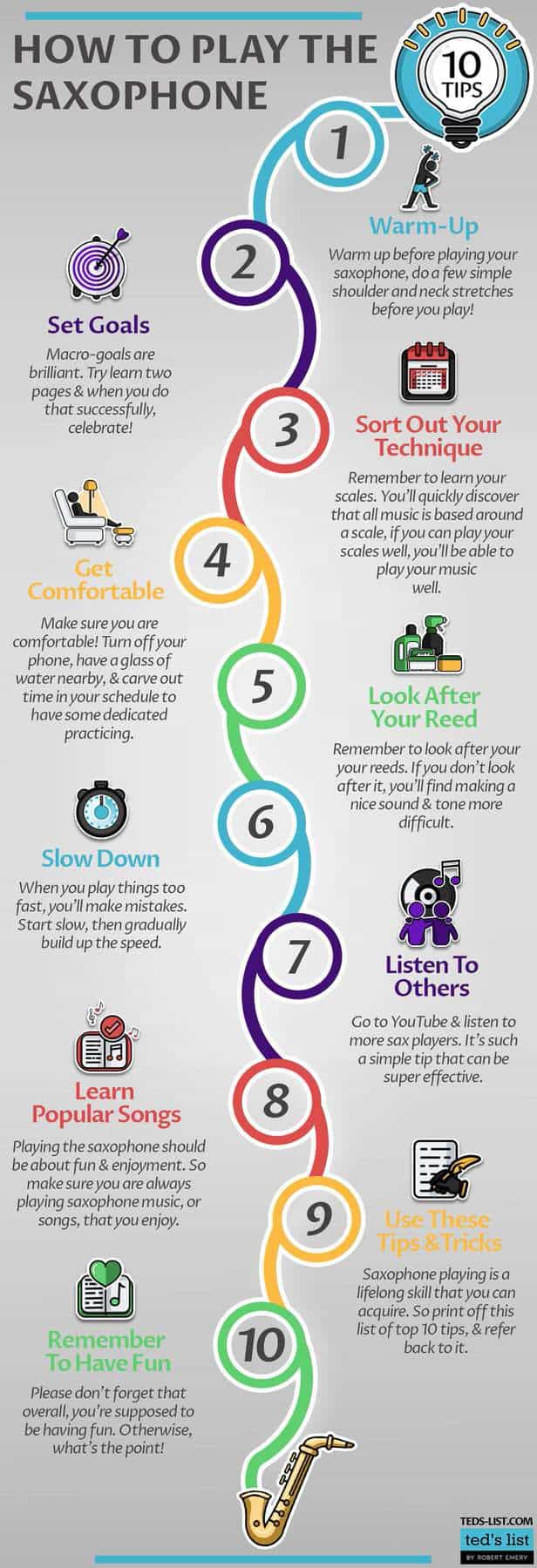Ever dreamt of blowing the saxophone and nailing it as brilliantly as a top jazz artist?
It’s simpler than you think, and it all begins with a few basic tips. Using a lot of air is essential; you must take a deep breath from your belly to support your sound.
To get started, hold your saxophone correctly and ensure the parts are lined up. Good breath control and practice techniques will help you master those long, soulful notes.
Ready to jump in and play your first song? Keep reading, and let’s explore these top tips together!
Warm-Up
Are warm-ups really necessary?
Well, to play the saxophone, you need to work hard, practice, and most importantly, have a great technique. And all of that can come with the toll of backache, arm pain, wrist tension, to name just a few things.
So if you’d like to avoid those not-so-fun symptoms of sax playing, I’d advise a nice warm-up; just to get you started…

Set Goals
We all need goals in life to move forward. Playing the saxophone isn’t just about sitting down to start playing music; it’s about planning what you’re going to learn, and how you’ll get there. Macro-goals are brilliant. Don’t say you’ll learn a whole piece of music in 30 minutes! Instead, say you’ll learn two pages. And when you do that successfully, celebrate.

This of course applies just as easily to learning Twinkle, Twinkle, Little Star, as it does to the most difficult saxophone jazz solo.
Set goals, set your time to practice, and go and do it!
Sort out your technique
I know working on your technique isn’t the most fun thing in the world, but it is crucial. If you are a complete beginner at the start of your musical journey, just read about it here in our ‘Beginners Guide to Playing the Saxophone‘ – and you’ll find out why. Learning sax is difficult, and there are so many elements to think about. Remember to look after your mouthpiece and your reeds. If you don’t, playing will be much harder, as I’m sure all saxophonists will tell you!
And whilst we are talking technique, remember to learn your scales. Although they are boring, you’ll quickly discover that all music is based around a scale of some sort – so if you can play your scales well, you’ll be able to play your music well. Beginners always find this one of the most difficult elements.

Get Comfortable
You’ll probably see your saxophone music teacher once a week, at best. The majority of the time you’re practicing the sax by yourself, so make sure you are comfortable! Turn off your phone, have a glass of water nearby, and carve out time in your schedule to have some dedicated practicing. It doesn’t matter if it’s 20 minutes or two hours, it’s the quality of the practice that matters.

Look after your reed
Your reed is the conduit between you and the instrument. If you don’t look after it, it doesn’t matter if you have the best saxophone in the world, you’ll find making a nice sound and tone more difficult. All saxophonists have to learn this, and you are no exception! So treat your reed (and your mouthpiece!) well. The reeds we recommend are here.
Slow down
We can’t stress this saxophone practice tip enough. Good musicians learn how to practice a fast piece at a tenth of its speed, and then gradually speed it back up to a normal pace. And what is the reason for this? Your brain!
When you play things too fast, you’ll make mistakes. Every time you play the saxophone, your brain is learning what you play. It learns the correct notes you play, but it also learns the mistakes. So if you are playing too fast, and making lots of errors, your brain will be learning those errors.
The alternative, which is our suggestion, is to go slooooooow. This way, you won’t make errors, and your brain will only learn how to play the piece correctly. When you gradually build up the speed, your brain also builds up the neurons of how to play the piece. And eventually, learning to play like this will mean minimal mistakes and your best performance. When you see on the sheet music is what you will play on the sax
Listen to others
Name your top five favourite saxophonists. You have to know what “great” sounds like to sound great yourself, so if you don’t have the list, go to YouTube and listen to more sax players. It’s such a simple tip that can be super effective. Listen to players from different musical styles as well. It all helps to make you the best musician and saxophone player possible.
Learn popular songs
Playing the saxophone isn’t always about the exercises and exam pieces that you need for your saxophone lessons. It should also be about fun and enjoyment. So make sure you are always playing saxophone music, or songs, that you enjoy and that are popular. Never forget you are learning to play the sax as an enjoyable way to spend your time!
Remember to use these tips and trick
Final Thoughts! It may sound obvious, but this list of saxophone tips and tricks will be helpful forevermore. Saxophone playing is a lifelong skill that you can acquire. And learning the instrument is not just about saxophone practice, sax lessons, reading the sheet music correctly, remembering all the chords and keys, playing in tempo, playing the correct rhythm and using the correct fingers (I could literally go on all day with this list). It’s about enjoying yourself. And like most things in life, if you see rapid progress, you’ll enjoy things more. And if you enjoy things more, you’ll make more progress.
It’s the circle of life! So remember to print off this list of top 10 tips, and refer back to it regularly.
Remember to have fun
There are so many things to think about whilst you play; making a nice sound, looking after your reed, practicing scales, working on your technique, learning your fingering, learning the music your sax teacher has asked, the list literally goes on and on. So please, please, don’t forget that overall, you’re supposed to be having fun. Otherwise, what’s the point!
Do you want to share this infographic on your site? Use this code...
FAQ's
Yes, a lot of people in the jazz world teach themselves. So you can teach yourself to play the saxophone, although we would strongly recommend getting lessons.
Like all woodwind instruments, you get really good at the saxophone by practice. It’s a simple as that! It’s an amazing instrument, but you still need to put in the work, like all great musicians.
There are no fixed rules on how many hours a day you should practice the saxophone. It’s not really about the length of time that matters – but more about the quality of your practice. It’s easy to do two hours of unproductive practice, where you are thinking about other things. But it’s much more useful to do twenty minutes of focused practice, where you are fully emersed in your sax playing.
The easiest saxophone to learn is either the alto or the tenor saxophone.












If slow and steady wins the race, my saxophone must think it’s a snail. At least it sounds better than a tortoise?
I get the part about setting goals, but how do you keep motivated when you’re just not getting it? Feels like I’ve hit a wall and could use some pointers.
ClarkeB, it’s all about the small wins! Try celebrating the little improvements and maybe mix up your practice routines to keep things fresh.
getting comfy is underrated. took me ages to find the right strap and posture, but it changed everything. kinda wish more folks talked about this stuff.
Loved the tip about looking after your reed, never knew how big of a difference it could make! Thanks, Guy Passey for the insights.